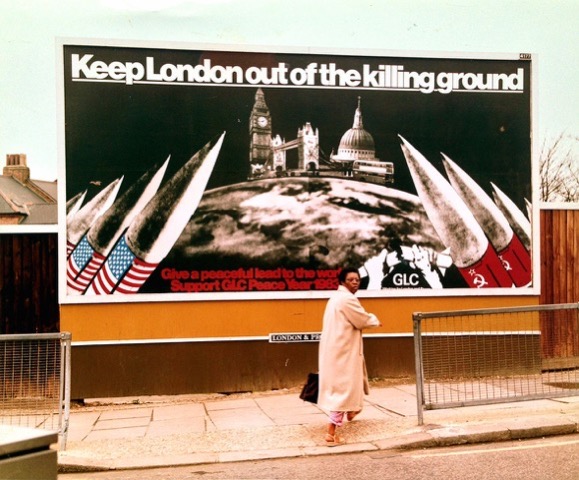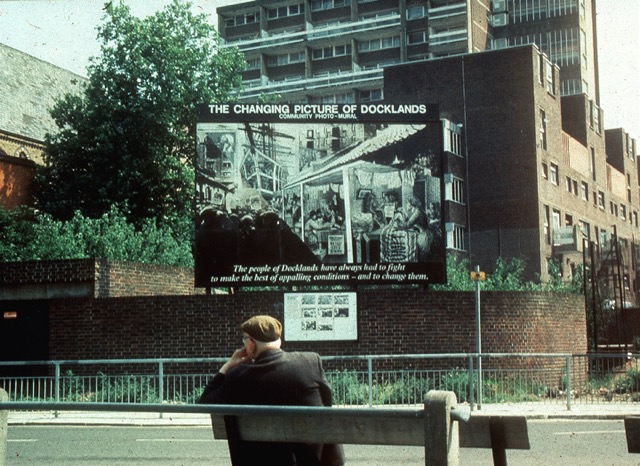Hazel Atashroo’s doctoral research project is the product of an AHRC supported Collaborative Doctoral Award between Winchester School of Art, University of Southampton and Tate, entitled ‘Connected Communities in Art and Design since the 1980s’. This is part of a four-PhD research project, and follows on from Oliver Peterson Gilbert’s study of connected communities in art and design since the 1960s. In the first year of her project, Hazel assisted on the exhibition ‘Keywords: Art, Culture and Society in 1980s Britain’ (2014) at Tate Liverpool, and conducted an in-depth visitor survey and report. The subject of her thesis was tangentially prompted by aspects of the Keywords exhibition’s video selection, in addition to a curiosity about the development since the 1980s of the rhetoric of ‘community’ as it appears in discourses of governance and in public museums. These interests led her to discover the radical and controversial community-targeted cultural policies enacted by the Labour Greater London Council (GLC) during its final term in office. The following article offers an overview of her research to date.

‘We will use expenditure on the Arts not to provide the icing on the cake, but as a part of the political ingredient of that cake… I want to see the arts integrated into socialist policy.’ Tony Banks, (Chair of the GLC Arts and Recreation Committee) (Sunday Times, 17th May 1981).
In April 1981, Ken Livingstone’s Labour left group, a post-1968 generation of young politicians, gained control of the Greater London Council (GLC), placing reform firmly on the agenda. The GLC was London’s metropolitan county council, the upper-tier of local government for the Greater London area. Occupying an oppositional stance towards the policies of Thatcher’s New Right in central government, the Labour GLC was able to initiate a number of radical reforms in its brief term in office, prior to the abolition of metropolitan county councils by the Conservatives in April 1986.
In the cultural field, the GLC’s experimental reform of cultural sponsorship objectives and new ‘cultural industries’ strategy particularly targeted the independent and voluntary sectors, also aiming to address the needs of frequently overlooked, socially diverse, multi-cultural inhabitants of the inner London boroughs. The experiments represent an early, rare instance of a UK local government body taking a serious interest in the political potential of cultural policy, in which distinct approaches were pursued across different departments, with varying levels of success.
Tony Banks’ GLC Arts and Recreation Committee were able to embrace a far broader, and more politicised definition of culture in comparison to the Arts Council, and over five years, it supported a wide range of cultural forms, beyond the major London theatre and ballet companies. These included community arts centres specifically for black and minority ethnic groups or for gay and lesbian Londoners, popular music projects for young people, women’s video workshops, a festival of world cinema, art exhibitions and cultural projects by Black artists, independent theatre groups, local history and literature workshops, community bookshops, a programme of public festivals in parks, and even sports facilities.
Cultural sponsorship frequently tied into GLC public campaign issues, particularly those against unemployment, ‘race’, sex and gender discrimination, the controversial redevelopment of what came to be known as London’s Docklands, and matters of civil defence – often contradicting central government policy.
One of the GLC’s many responsibilities included planning for the consequences of a nuclear attack on London, in co-operation with central government. The exposure of classified civil defence plans revealed the truth about the devastating effects of a nuclear attack, thereby rendering the advice of the government’s infamous 1980 public information booklet, Protect and Survive, a wholly inadequate response to the threat.
Livingstone’s Labour GLC chose not to co-operate with the Conservative government’s plans to abandon Londoners in the event of a nuclear attack, and instead transferred funds for war preparations to a GLC campaign for unilateral nuclear disarmament, thereby aligning the GLC with the CND and women’s peace camp at Greenham Common. Declaring 1983 ‘GLC Peace Year’, Livingstone announced that London was to become a ‘Nuclear-Free zone’.

Photograph by the GLC, collection of the artist.
Artist Peter Kennard won the ‘pitch’ against advertising agencies to promote GLC Peace Year with a series of arresting photo-montages, placed on public billboards around London. Similar posters were sent out in packs, free of charge to hundreds of community groups and activists, who applied from all over the country.

As well as employing cultural producers directly to promote campaigns, the GLC more frequently left it to organised community groups to pursue their own activism through public cultural projects. Consulting with local tenants action groups, community artist team Loraine Leeson and Peter Dunn facilitated the Docklands Community Poster Project, which sought to amplify the objections of local people to the moneyed might of the encroaching London Docklands Development Corporation in Tower Hamlets. One outcome of the project was a series of photo-murals, communicating the situation to local residents. In another, The People’s Armada To Parliament, a barge hung with banners was sailed past the houses of parliament during ‘GLC Thames Day’ festivities on the South Bank. The project successfully brought the local campaign to national press attention.
I intend for my thesis to provide a critical account of aspects of the community-targeted cultural policies of the Greater London Council (GLC), between 1981-86. It will consider the GLC’s efforts to sponsor politically engaged cultural production by, and for, newly recognised constituencies in London. While written accounts detailing these cultural policies exist, I aim to explore how grants and cultural policies actually played out in London’s cultural field. What did GLC sponsorship mean, for groups of cultural producers who might not have otherwise been funded under the auspices of traditional state sponsorship?
My thesis will focus on case studies of GLC grant-aided public media projects, and what are sometimes referred to as ‘community media’ ‘access workshops’, groups of cultural producers working with video, photography and print media, whose efforts were often directed towards providing communities and local activists with communications media training and resources. The GLC supported more than thirty organisations working in independent film and video production and distribution, in addition to more than ten established community photography workshops, photographic agencies, poster projects and print workshops.
I will use the GLC’s policies, and its records of recipients of GLC support as framework to discuss ‘community media’ activism in London in the 1980s, and more generally, the role of politics in culture and cultural policy.
